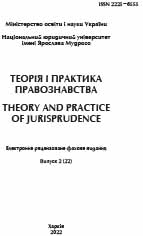Основні риси системи організації державної влади за Конституцією КНР 1982 року
The Main Features of the System of Organization of State Power under the Constitution of the People’s
Republic of China of 1982
Author(s): Vitaly A. LizogubSubject(s): Law, Constitution, Jurisprudence, Governance, Government/Political systems
Published by: Національний юридичний університет імені Ярослава Мудрого
Keywords: 1982 Constitution of the People’s Republic of China; political system; Communist Party of China; National People’s Congress; state council; People’s Political Consultative Council; political parties;
Summary/Abstract: The article is devoted to a comprehensive analysis of the fundamental components of the state constitutional system of the People’s Republic of China and its evolution. Based on the analysis of the works of famous foreign and domestic Chinese scientists, the traditions of the political system of the People’s Republic of China using general scientific and special methods (dialectical, comparative, logical, system-structural, functional, analysis and synthesis methods), the main characteristic features of the Constitution of the People’s Republic of China in the 2018 edition were studied years, related to changes in the state and social system of China during the second half of the 20th century, especially with the processes of the second decade of the 21st century. In particular, the essence of the system of organization of state power according to the 1982 Constitution of the People’s Republic of China, amendments and changes to the norms of the constitutional legislation of the People’s Republic of China at various stages of its history, forms of state organization, contours of the system of higher and local state authorities of the People’s Republic of China, the sphere of competence of individual state authorities in the People’s Republic of China, their specific functions, which have a certain purpose, aimed at meeting the relevant needs of the state as a system. In addition, the main elements of the political system, including the structure of the party system, and state policy regarding national minorities are analyzed. Conclusions are made about the main stages of the history of the development of the Constitution of the People’s Republic of China, the influence of the official ideology of Marxism and Maoism, the socialist system as the basis of the People’s Republic of China, the place of the Communist Party of China in the state and political system of the country. The issue of the socialist approach to the rights and responsibilities of the citizen, the lack of a real state guarantee of the declared right to work and the significant limitation of the realization of the right to education, the single right to social security in old age on a nationwide scale, is highlighted. The exceptional place of state property in the economy of the People’s Republic of China, the evolution of the form of state government, the principle of popular sovereignty as the core principle of the organization of political power is shown, and the counter-liberal and radical changes of 2018 associated with the strengthening of the power of the President of the People’s Republic of China are characterized.
Journal: Теорія і практика правознавства
- Issue Year: 2/2022
- Issue No: 22
- Page Range: 22-39
- Page Count: 18
- Language: Ukrainian

